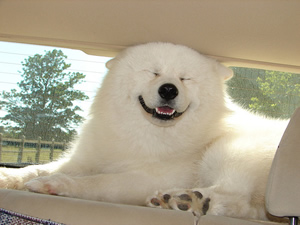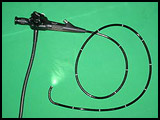
1. For portraits: Get closer.
When you think you抮e close enough, cut that distance in half! Most 搒napshots?(not 損hotographs? are taken from too far away. Consequently the features are too small and the picture lacks impact.
2. Eliminate distracting backgrounds.
A simple wall, or bed sheet backdrop, can dramatically improve your picture.
3. Avoid flash.
The light from camera-mounted flash units will flatten your dog抯 features and may produce the dreaded 搑edeye?problem. Flash also produces nasty shadows on walls behind your dog. Indoor portraits taken using the light from a north-facing window can be spectacular. Add a reflective white surface, such as a piece of white cardboard, held just off camera can be used to bounce some light into the shadow side of your dog. You抣l need an assistant to hold the reflector while you see the results in your camera. Photographs taken outdoors in the shade often produce excellent results. An overcast day is often ideal. But remember that outdoors Fido might just take off after that squirrel rather than sit still for his portrait.
4. Whenever possible, use a tripod.
The professionals get better results because they can compose their images more precisely and can eliminate camera shake by using a tripod. Try getting down low ?at your dog抯 eye level ?for a more 搃ntimate?portrait. And try placing your dog off-center for a more dynamic portrait.
5. If you are using a digital camera remember to set the 搘hite balance?to the appropriate light source.
If your pictures have an orange coloration to them when taken indoors it抯 because the camera white balance was set to 揹aylight?rather than to 搕ungsten?(normal light bulbs). If you set the white balance to tungsten and then go outside to photograph your pictures will be too blue ?switch back to 揹aylight?or 搒hade?etc. And consider converting your color images to black and white -- this can be very effective.
6. Experiment – zoom in and zoom out.
Most digital cameras have zoom lenses that can produce quite different results at various zoom settings. Typically a basic point-and-shoot camera has a 3x zoom lens. The best results are often (but not always) somewhere in the middle of the zoom range.
7. Take lots of pictures!
You wouldn抰 expect to find the perfect shirt in a store that had only one to pick from. Take more pictures than you think you need; you can always delete the bad ones. I tell my students to take at least 30 images of everything - more if possible.
8. Always be ready!
Wonderful photographs can be made by capturing your dog doing something special, in unusual surroundings or with unusual lighting. Most of these pictures happen spontaneously so you have to be ready. Have your camera with you all the time and be ready for that special moment.
9. Know your dog!
Every dog (and every person) has a unique personality. Try to capture those moments when Fido is extra cute.
10. Dress up your best photos
Put your best photographs in white mattes that are at least 2 綌 wide (I make mine at least 3?on the top and sides and slightly larger on the bottom c. 3 綌). You抣l be amazed how much better your images will look if they are presented in a professional manner.
 Adventures with Your Dog: 23 Ways To Spend Quality Time With Your Pooch!
23 Great Adventures With Your Dog
Its important to spend
Adventures with Your Dog: 23 Ways To Spend Quality Time With Your Pooch!
23 Great Adventures With Your Dog
Its important to spend
 Four Helpful Truths About Blindness in Dogs
If youre reading this theres
Four Helpful Truths About Blindness in Dogs
If youre reading this theres
 Top 10 Healthiest Dog Breeds
Woof!No other animal has aid
Top 10 Healthiest Dog Breeds
Woof!No other animal has aid
 Choosing the best dog toys for your dog or puppy
Choosing the Best Dog Toys - Plus Our Favorites!
Choosing t
Choosing the best dog toys for your dog or puppy
Choosing the Best Dog Toys - Plus Our Favorites!
Choosing t
 Dogs Cats and Endoscopy
Dogs Cats and Endoscopy
Dogs Cats and Endoscopy
Dogs Cats and Endoscopy
Copyright © 2005-2016 Pet Information All Rights Reserved
Contact us: www162date@outlook.com